The iPhone 5c Review
by Anand Lal Shimpi on September 17, 2013 9:01 PM EST- Posted in
- Smartphones
- Apple
- Mobile
- iPhone
- iPhone 5C
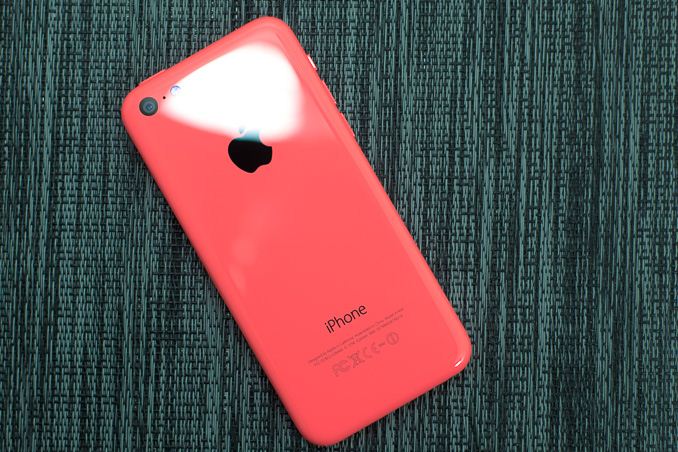
For years now Apple has followed a rather intelligent waterfall of its products down the pricing stack. With the arrival of every new iPhone, the previous generation gets a $100 discount from its on-contract price, and the generation before that one is offered for free on-contract. In the early days of this strategy, it was a great way to continue to build up the iOS user base without having to compete in the lower margin feature phone space. The strategy worked quite well.
During the days of the iPhone 4S the strategy made a ton of sense, as the 3GS was undoubtedly cheaper to manufacturer than the glass + metal iPhone 4 and 4S designs. No attention was paid to the impact on the iOS brand however of having a bunch of customers walking around with new 3GSes as recently as late 2011.
With the iPhone 5s however, Apple was caught in an interesting situation. The previous model leveraged the same industrial design, and it’s definitely not a cheap one at that. Capacitive touchscreen display costs increase with display size, making the iPhone 5’s display a more expensive option than its predecessor. Add in other flagship features like in-cell touch and premium construction and the iPhone 5 quickly became a device that Apple would rather not discount.
Keep in mind that Apple built its phone business much like it built its Mac business, by focusing exclusively on higher margin products. The incredible volumes that followed were a side effect of the state of the industry, not a deliberate change in business model. With its core motivations unchanged, Apple needed a solution to continue to make the 3 phone strategy work. The solution is the iPhone 5c:
The iPhone 5c leverages the entirety of the iPhone 5 hardware platform, but moves from a glass + aluminum construction down to a more cost effective glass + polycarbonate design. The iPhone 5c retains all other features of the iPhone 5 including in-cell touch, Lightning connector, the same rear facing iSight camera stack and A6 SoC. It even brings some new features to the table like sharing the same front facing FaceTime HD camera as the iPhone 5s. Other elements aren’t necessarily newer but are at least shared with the 5s platform. For example, the WiFi, cellular and BT hardware is different than the iPhone 5, but shared across the 5c and 5s. Having as many common components between Apple’s two iPhones at this point is another great way to capitalize on economies of scale.
The savings on materials however is enough to allow Apple to sell the iPhone 5c in place of the outgoing 5. With a 2-year contract Apple expects a 16GB 5c to sell for $99, and a 32GB for $199. These are exactly the same price points you’d expect the iPhone 5 to drop to after the introduction of the 5s. Anyone expecting the 5c to be Apple’s solution for volume in China or somehow compete in the feature phone space will be disappointed. At the same time, anyone who is familiar with Apple’s business will know that a low cost volume play was never in the cards.
The 5c comes in iPod touch-like packaging but still includes a pair of Apple EarPods (with remote and mic), a 5W wall adapter and a Lightning cable.
| Apple iPhone 5 | Apple iPhone 5c | Apple iPhone 5s | |
| SoC | Apple A6 | Apple A6 | Apple A7 |
| Display | 4-inch 1136 x 640 LCD sRGB coverage with in-cell touch | ||
| RAM | 1GB LPDDR2 | 1GB LPDDR3 | |
| WiFi | 2.4/5GHz 802.11a/b/g/n, BT 4.0 | ||
| Storage | 16GB/32GB/64GB | 16GB/32GB | 16GB/32GB/64GB |
| I/O | Lightning connector, 3.5mm headphone | ||
| Current OS | iOS 7 | ||
| Battery | 1440 mAh, 3.8V, 5.45 Whr | 1507 mAh, 3.8V, 5.73 Whr | 1570 mAh, 3.8V, 5.96 Whr |
| Size / Mass | 123.8 x 58.6 x 7.6 mm, 112 grams | 124.4 x 59.2 x 8.97 mm, 132 grams | 123.8 x 58.6 x 7.6 mm, 112 grams |
| Camera |
8MP iSight with 1.4µm pixels Rear Facing 1.2MP with 1.75µm pixels Front Facing |
8MP iSight with 1.4µm pixels Rear Facing 1.2MP with 1.9µm pixels Front Facing |
8MP iSight with 1.5µm pixels Rear Facing + True Tone Flash 1.2MP with 1.9µm pixels Front Facing |
| Price | $199 (16GB), $299 (32GB), $399 (64GB) on 2 year contract | $99 (16GB), $199 (32GB) on 2 year contract | $199 (16GB), $299 (32GB), $399 (64GB) on 2 year contract |
In fact if we look back at the period of netbook success during the late 2000s, Apple was often under pressure to compete in that space. Instead of putting out a low cost PC competitor, Apple eventually brought the iPad to market - a completely different device, with a very different cost structure, to compete with those lower cost PCs. I don’t know that Apple has to do the same thing here, but if you’re looking for an ultra cheap mobile computing device from Apple - it may not look like a phone.

iPhone 5c (left) vs. iPhone 5s (right)
The smartphone market is definitely maturing. We’ve passed the point of everyone being an early adopter to smartphones now encompassing a larger section of the technology buying pyramid. For people further away from the early adopter summit (further down the pyramid), carrying the absolute latest technology isn’t always at the top of the purchasing decision tree. We are seeing an increased number of smartphone manufacturers play with the use of color in their devices to go after this more mainstream market where the color of your phone may be just as important (if not more) than what SoC is inside.
Motorola recently embraced this trend by offering a huge number of color customizations on the Moto X. We’ve had brightly colored phones from HTC in the past as well, and there’s no way we can have a discussion of color without mentioning Nokia of course. With the 5c, Apple joins the ranks of smartphone companies shipping phones in pretty colors - a side benefit of the iPhone 5c being made out of a polycarbonate material.
The iPhone 5c isn’t, of course, Apple’s first polycarbonate phone. The iPhone 3G and 3GS both relied on plastics before an eventual transition to the glass + metal combination that we got with the newer iPhones.
The 5c is available in five colors: blue, white, green, yellow and pink. I was sampled a pink 5c. Color preferences can definitely get very personal, but for what it’s worth I really like the pink 5c. It’s sort of a combination of pink and coral rather than a bright pink.
The final finish on the 5c is smooth and looks a lot like what you see when you open up a can of brightly colored paint. As with all plastic/polycarbonate phones with a glossy finish, smudges are easily picked up by the iPhone 5c. The colors are light/bright enough where smudges on the device aren’t hugely distracting though, and of course the smooth back surface is easy to wipe off.
Apple offers a line of first party cases for the iPhone 5c. These are soft touch silicon rubber cases, and they are available in six different colors (white, black, blue, yellow, green and pink). Apple’s iPhone 5c cases still allow some color to shine through on the front, and are perforated with large holes to let color through on the back as well. I can’t say I’m a huge fan of the styling of the back of the case but otherwise I like them. The rubber surface is grippy and the inside of the case is made of a microfiber-like material to prevent scratching. I’ve found that the holes on the back of the case do let dirt in between the case and the phone unfortunately.
The combination of 5c color and case color is Apple’s answer to those who want even more customization on the styling of their phone. Similar to what Motorola is doing with the Moto X, the default background of your 5c will match the color you purchase.
The iPhone 5c follows largely the same shape as the iPhone 5 and 5s, but with a twist. Since the 5c’s back is built from a polycarbonate material, it’s much easier to deliver smoothly rounded corners and edges. The result is a device that feels great in hand. I’d actually argue that other than the added weight, the 5c maybe even feels better in hand than the iPhone 5/5s. The same complaints that apply to the 5/5s obviously apply to the 5c - mainly that if you want a bigger display, you’re not getting one here.
The 5c follows the same button layout as the iPhone 5/5s. Power/lock is up top, volume up/down are on the left with the silence switch and there’s a physical home button on the front of the device. Unlike the iPhone 5s, the 5c doesn’t get Touch ID so the home button looks no different than it did on the iPhone 5.
All of the buttons on the 5c feel great, something Brian noticed in his hands on with the device. The internal vibrator motor feels identical to that of the iPhone 5s, and at a slightly higher frequency compared to the original iPhone 5. Again I wouldn’t be too surprised to see as much parts bin sharing as possible between the 5s and 5c.
Display
The iPhone 5c's display is identical to that of the iPhone 5 and 5s. It's the same 4-inch 1136 x 640 Retina Display that Apple launched last year. Apple seems to multi-source the panel as the quality of the one in my 5c review sample was the best iPhone Retina Display I've ever tested. I'm presenting a subset of our display tests below, if you want more detail you can check out our iPhone 5s review:
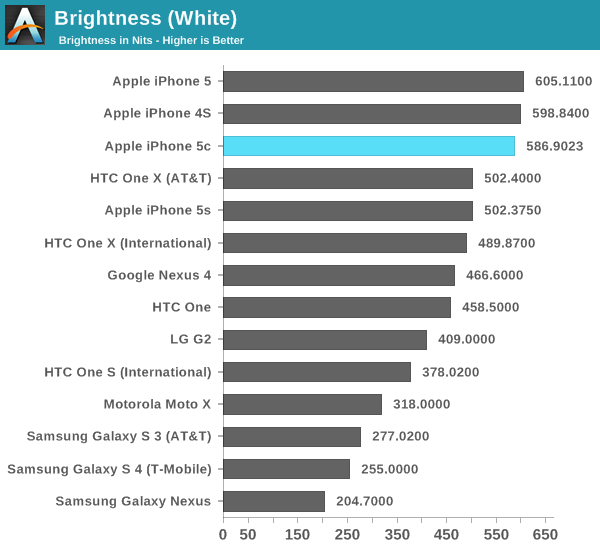
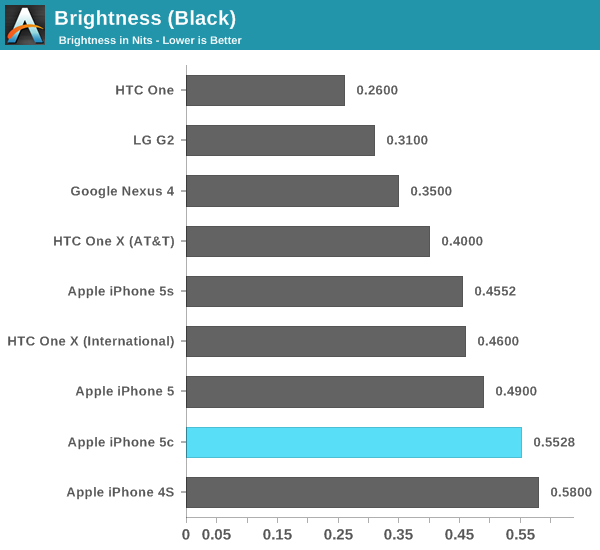


The 5c's display is incredibly bright, has the best color reproduction of any other phone we've tested and has more than enough contrast.
Internally Apple is quite proud of the steel reinforced frame that gives the iPhone 5c its rigidity. In practice, the 5c has virtually no noticeable chassis flex. It’s an easy victory for Apple because the 5c doesn’t have to be a flagship device, and thus doesn’t have to be as thin as possible. Apple can rely on the 5s pursuing the as-thin-as-can-be market, giving the 5c room to be a bit thicker and thus feel a bit more solid. I agree with Brian in that not all plastic/polycarbonate devices have to feel cheap (see: HTC, Nokia), and the iPhone 5c definitely doesn’t. It’s a different feel than the softer/matte polycarbonate designs I’ve seen in that it’s definitely more slippery.
Battery Life
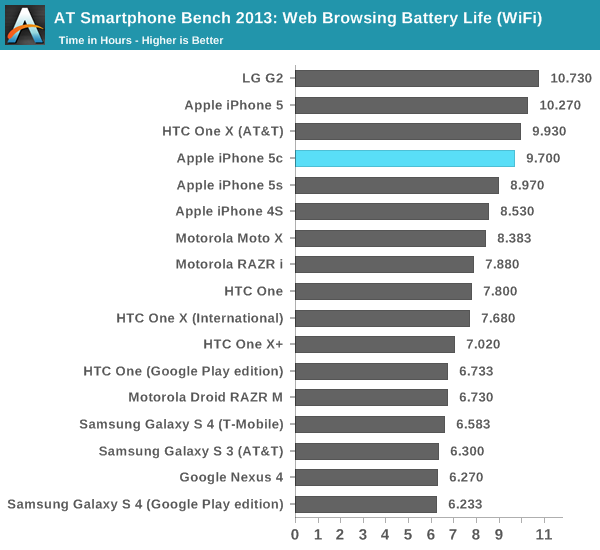


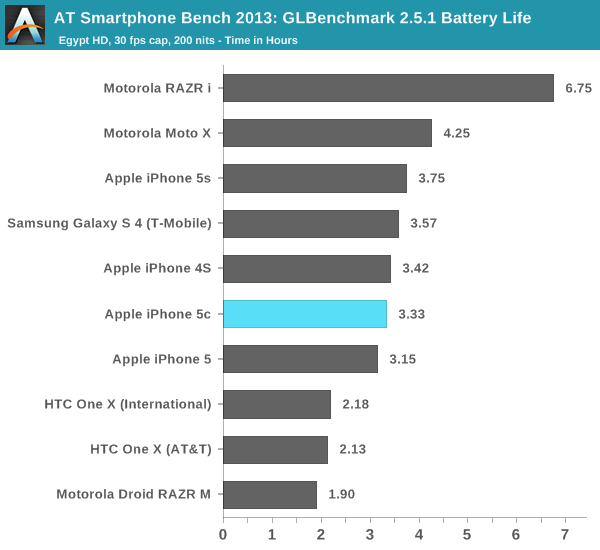
I do see some small changes in battery life results compared to the iPhone 5, but at this point I’m chalking that up to minor hardware differences in the 5c as well as the fact that we are comparing across iOS versions here (iOS 7 on the 5c vs. iOS 6 on the 5). Web browsing battery life on the 5c is quite good, but if you stress the SoC a lot or look at call time performance the 5c's behavior is mostly dictated by battery capacity, which is definitely more middle of the road rather than flagship.
CPU Performance
The performance of the 5c under iOS 7 is still quite good. I feel like Apple outpaced its own software requirements with the iPhone 5s’ A7 SoC as iOS feels pretty quick on both platforms at this point. Obviously the big downside to going with the 5c over the slightly more expensive 5s is that you lose 64-bit support and do have a much slower CPU, both of which may become more of a pain if you keep the phone for a long time.
Octane and SunSpider both have the iPhone 5c doing relatively well for a non-flagship device, but the platform's performance in Kraken is starting to look quite dated. Browsermark is arguably the most interesting test here as it attempts to present a holistic view of browser performance rather than just focusing on js subtests. Under Browsermark, the still looks quite competitive.
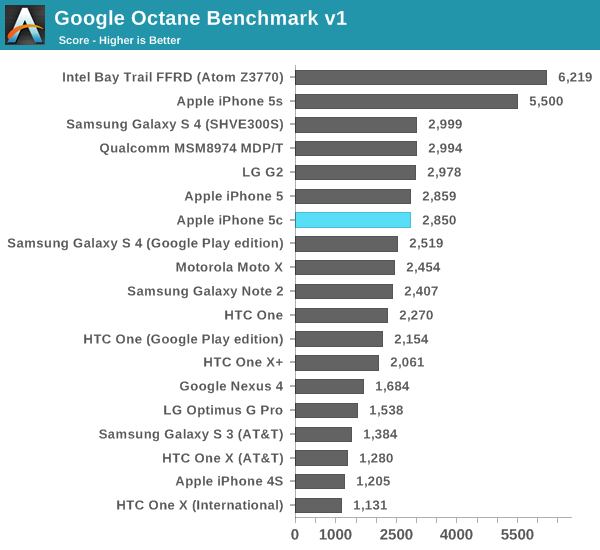
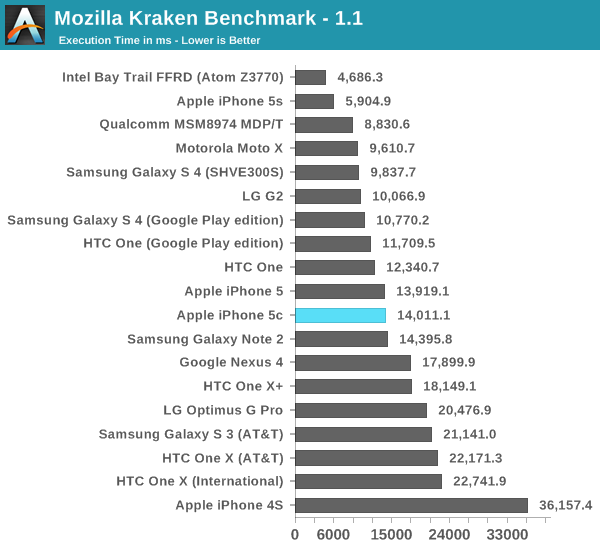
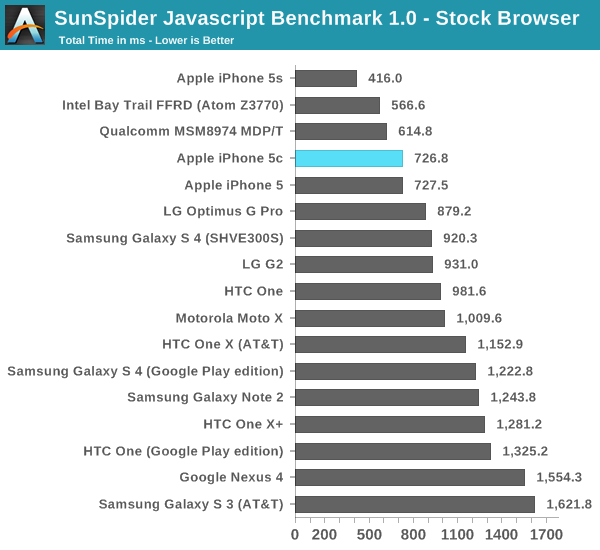
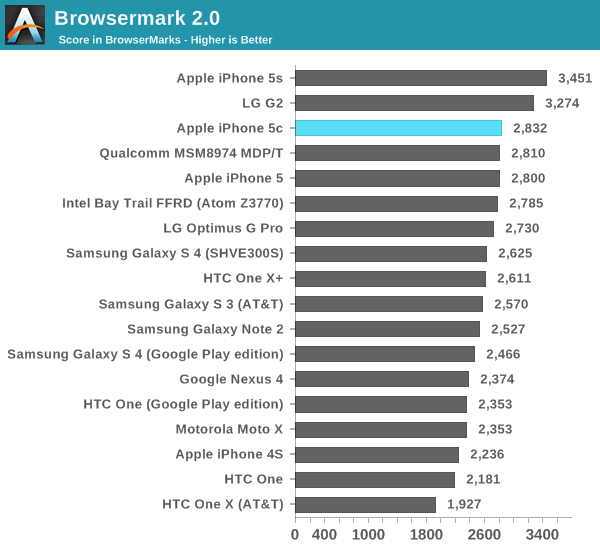
GPU Performance
The latest flagship smartphones have pushed GPU performance far beyond where Apple was with the PowerVR SGX 543MP3 last year. Performance at the 5c's native display resolution is still quite compelling, but if you want the platform to last for a few years in terms of usable 3D gaming life it will definitely age quicker than the 5s or any of the Adreno 320/330 based flagships we've tested.
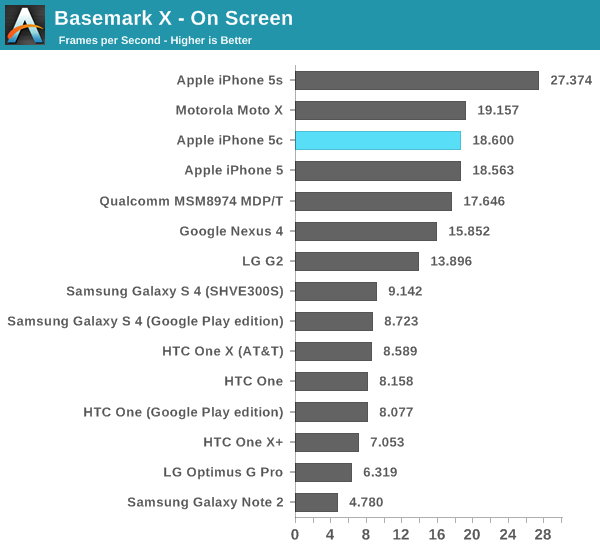
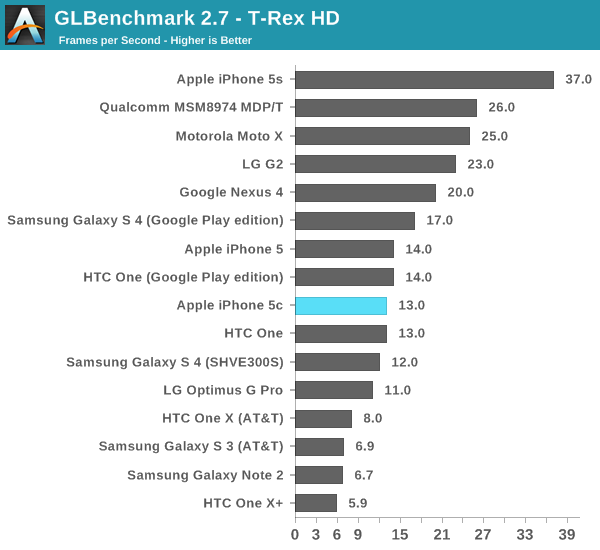

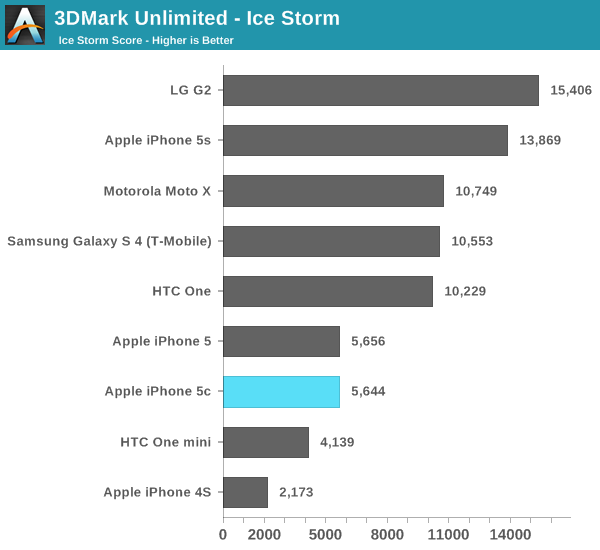
Camera, Cellular & WiFi
Rear camera quality of the iPhone 5c is identical to the iPhone 5 as it is physically the same camera module. The front facing camera on the other hand is identical to the iPhone 5s. The result is a pair of competent shooters, but you definitely don’t get the move forward in low light performance from the 5s. I won’t go too deep into the camera analysis here as Brian did a great job of that in his piece on the original iPhone 5.
Cellular and WiFi performance seem identical between the iPhone 5c and iPhone 5s. Apple claims both platforms are using the same hardware and have roughly the same antenna layouts. The 5c’s internal steel frame plays a double role as an antenna, although we won’t know exactly how until someone tears one of these down. Just like the 5s, the 5c features the same support for up to 13 LTE bands depending on the model:
| Apple iPhone 5S and 5C Banding | |||||||
| iPhone Model | GSM / EDGE Bands | WCDMA Bands | FDD-LTE Bands | TDD-LTE Bands | CDMA 1x / EVDO Rev A/B Bands | ||
|
5S- A1533 (GSM) |
850, 900, 1800, 1900 MHz | 850, 900, 1700/2100, 1900, 2100 MHz | 1, 2, 3, 4, 5, 8, 13, 17, 19, 20, 25 | N/A | N/A | ||
|
5S- A1533 (CDMA) |
800, 1700/2100, 1900, 2100 MHz | ||||||
|
5S- A1453 |
1, 2, 3, 4, 5, 8, 13, 17, 18, 19, 20, 25, 26 | ||||||
|
5S- A1457 5C- A1507 |
850, 900, 1900, 2100 MHz | 1, 2, 3, 5, 7, 8, 20 | N/A | ||||
|
5S- A1530 5C- A1529 |
1, 2, 3, 5, 7, 8, 20 | 38, 39, 40 | |||||
| Apple iPhone 5S/5C FCC IDs and Models | |||
| FCC ID | Model | ||
| BCG-E2642A | A1453 (5S) A1533 (5S) | ||
| BCG-E2644A | A1456 (5C) A1532 (5C) | ||
| BCG-E2643A | A1530 (5S) | ||
| BCG-E2643B | A1457 (5S) | ||
| BCG-E2694A | A1529 (5C) | ||
| BCG-E2694B | A1507 (5C) | ||
iOS & Software
The iPhone 5c ships with iOS 7 from the factory. Apple also recently made iPhoto, iMovie and its iWork suite free for anyone who buys a new iPhone preloaded with iOS 7 (the iPhone 5c and 5s). The list includes iPhoto, iMovie, Pages, Numbers and Keynote, a pretty substantial collection given how much Apple used to charge for all of them in the past ($40 total). Apple is clearly mimicking its successful Mac strategy here, leveraging software as a way to sell hardware. I’m actually surprised the five apps don’t come preloaded on the 5c, although I wouldn’t be too shocked to see that change in the future.
Final Words
The iPhone 5c is a well built device. For all intents and purposes it is a perfect replacement for the iPhone 5. If you were planning on buying a cost reduced iPhone 5 once the 5s came out, the iPhone 5c should have no problems filling that role. Its performance, battery life and camera quality are all on par with the 5.
Apple’s return to a polycarbonate iPhone design seems to have gone quite well. The iPhone 5c is solid, doesn’t have any noticeable amount of flex and has a great in hand feel thanks to its nicely curved edges. I feel like the color options will go over very well with the 5c’s target markets. I can see many users even preferring the styling of the 5c to the 5s in those markets that aren’t feature/performance sensitive.
Personally I’d prefer the iPhone 5s simply because of its more modern platform, even if I were recommending a device for someone else not as concerned with performance. Supporting the latest ISA (which will probably stick around for a while) and OpenGL ES 3.0 are both important if you’re going to be keeping your phone for a very long time and plan on using it for more than just the basic first party apps.
As I said before though, if your plan all along was to buy an iPhone 5 - the iPhone 5c is a clear substitute good. I don’t expect that we’ll see an even cheaper version, but I am excited for what happens when the 5s hardware waterfalls into the 5c replacement next year.
Apple throwing its hat into the multi-device race marks a very important change for the company. I’ve always believed that the smartphone space would end up looking a lot like the PC industry, or in Apple’s case, the Mac business. Apple presently offers a handful of Mac notebooks, and I see no reason why Apple will stop at two with the iPhone.


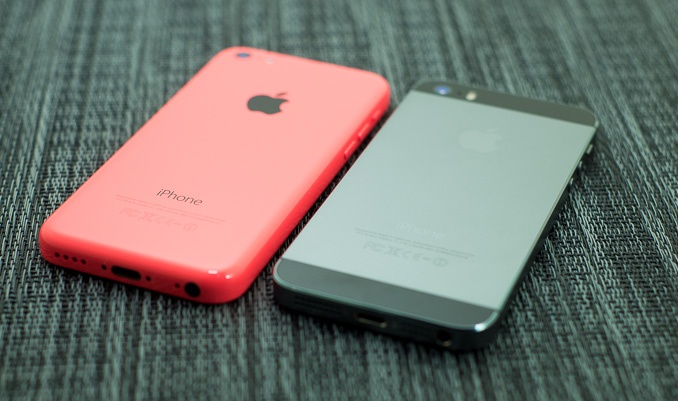
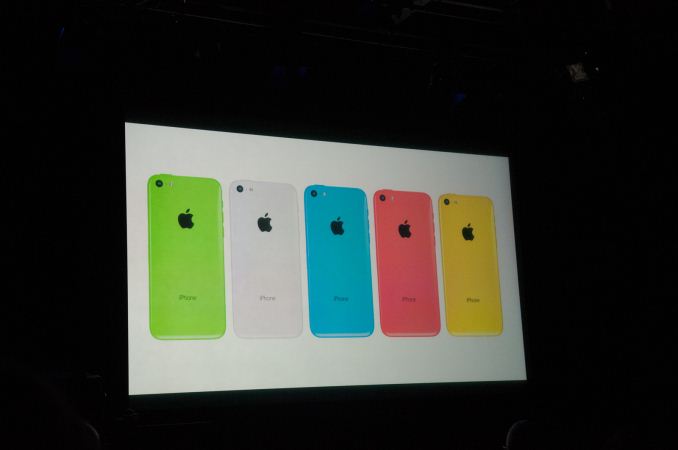

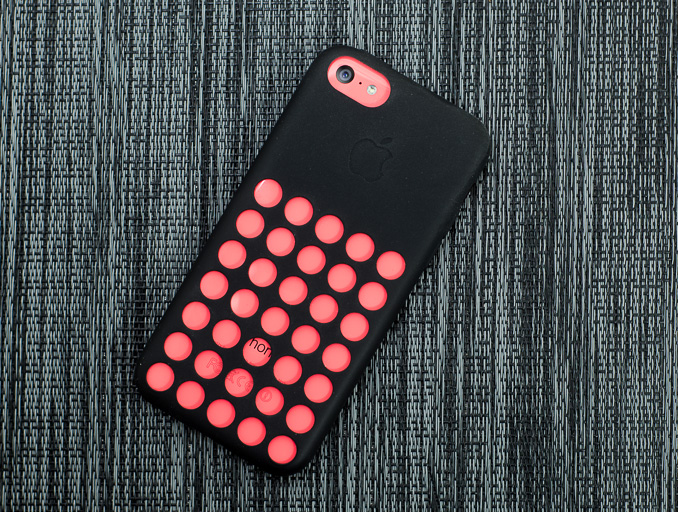






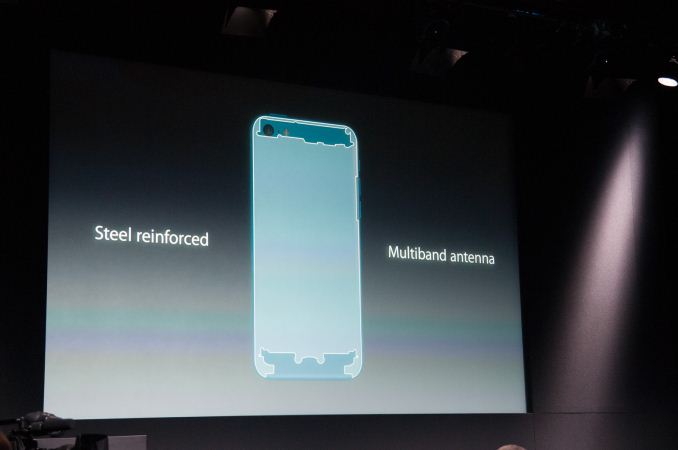














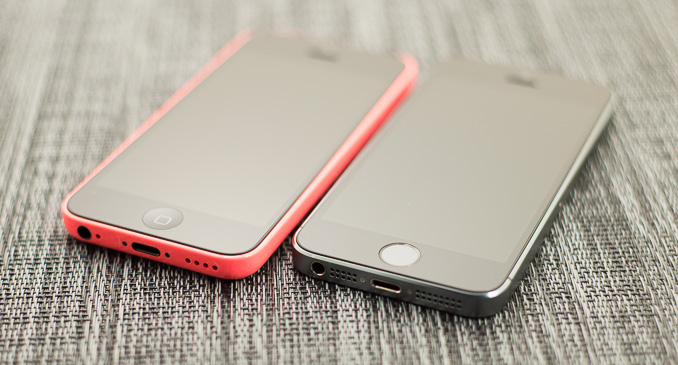








67 Comments
View All Comments
t_yamamoto - Tuesday, September 17, 2013 - link
I think you guys may have gotten the pricing wrong, as the 5c is supposed to be 100 dollars cheaper than the 5s.Ryan Smith - Tuesday, September 17, 2013 - link
Eep. Good catch. Thank you.MatthiasP - Tuesday, September 17, 2013 - link
If your plan all along was to buy an iPhone 5 then you should go and get it as long as you can, it is cheaper, lighter and has the way more premium design.blanarahul - Tuesday, September 17, 2013 - link
That was really quick!!"Personally I’d prefer the iPhone 5s simply because of its more modern platform, even if I were recommending a device for someone else not as concerned with performance."
Apple built the iPhone 5c for this exact reason!! More profits if customers buy 5S!!
Death666Angel - Wednesday, September 18, 2013 - link
Are the prices of the 5s inflated compared to previous years smartphone launches? I remember them being the same, so your argument makes no sense.Hrel - Wednesday, September 18, 2013 - link
5s likely has higher margins than the 5c. I think that's where he was going, but he's still wrong.Crono - Tuesday, September 17, 2013 - link
Wow, back-to-back reviews.The 5c isn't likely to appeal to as many AT readers as the general public, but it's good to see the comparison versus other devices so I know whether to recommend it or not to friends and family who "must" get an Apple device.
Appreciate the hard work, Anand. :)
BreakingBones - Tuesday, September 17, 2013 - link
Wow, looking at these numbers, Intel must be worried. Their window of opportunity is closing quick. Next year, the A8 might even surpass any Atom upgrade Intel plans to put out. Intel would have needed a few years of performance lead for developers to migrate all the native GL game code over to x86. Now, with the 64-bit Arm, they're likely gonna say it's wasted effort to port over to x86.teiglin - Wednesday, September 18, 2013 - link
Not sure I see the comparison. Certainly the A7 is impressive compared to Bay Trail but is Apple really going to start selling their silicon to other OEMs or even enterprise customers? I see the competition for Bay Trail as MSM8974, Cortex A57, or Kabini in the tablet space.As for next year, it seems a bit premature to judge. We know very little about Airmont and even less about the CPUs that will be in Apple's A8, and it'd take quite a shift from Apple to really place them as competitors (some unholy combination of iPad and Macbook Airs maybe?).
smartypnt4 - Wednesday, September 18, 2013 - link
This. Intel announced its first real push into mobile devices last week, and Apple can merely match their performance on the CPU side. The GPU side of things is easily fixed by them in the future, as they just need to see their mistake, recognize it, and correct their course. Stamp out some more EUs on Airmont (3x what Bay Trail has, so 12 total), while using the updated architecture found in either Haswell or Broadwell, and they'd be fine for next year. That's assuming that the CPU side holds up. Since it's Intel, I'd say that's a safe bet.